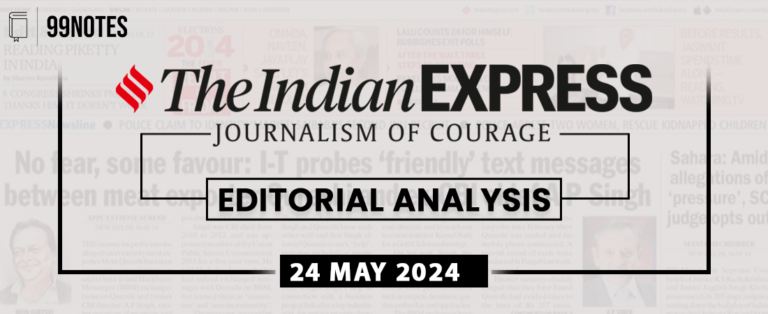28 Nov 2023 : Indian Express
Indian Express
28-November-2023
1) In DBT, D is for dignity
Context:
- Globally acclaimed as a logistical wonder, India’s Direct Benefit Transfer (DBT) system uses digital public infrastructure to immediately distribute beneficiaries’ rewards from multiple government initiatives.
- According to reports, DBT has been used in 310 government programs across 53 ministries, with an estimated 1.14 percent of GDP saved as a result.
Dignity Preservation as a Crucial Benefit:
- Although the usual conversations surrounding DBT center on eliminating corruption, cutting leaks, and expanding coverage, one important but little-discussed feature of DBT is that it upholds the dignity of the impoverished.
- The change in strategy, which sees government assistance flow straight to people without the need for middlemen, has a significant impact on the mental health of the impoverished.
Dignity in the Context of Poverty:
- When examining the notion of dignity in relation to poverty, it is recognized that, even in the absence of corruption or leaks, the impoverished have historically been required to participate in a “poverty parade” in order to get government assistance.
- In a civilized and compassionate society, it becomes imperative to acknowledge that every person, regardless of financial situation, has an equal right to dignity.
The Individual Rights Perspective on Poverty:
- A rights-based approach examines poverty from the standpoint of individual rights and deprivation, in contrast to the meritocratic view that holds that poverty is the result of a person’s lack of work or capacity.
- This strategy emphasizes shared responsibility within society and calls for an awareness of the historical circumstances that gave rise to poverty.
Burden of Poverty and Rawlsian Justice:
- A rights-based perspective holds that everyone in society, even the wealthy and privileged, bears some of the burden of poverty.
- Institutions need to be built with a Rawlsian understanding of fairness, understanding that luck and other outside forces beyond an individual’s control play a role in success in addition to inherent abilities.
Preserving Dignity Through DBT:
- The application of DBT helps to protect the impoverished’s dignity by removing the need for them to look for assistance from middlemen.
- By guaranteeing that the impoverished receive government benefits, DBT changes the perspective from one in which the poor receive benefits to one in which the benefits reach them.
Extending DBT Model to Other Areas:
- The article proposes applying DBT’s design ideas to other fields, such the legal system.
- The article highlights the cry of underprivileged inmates who lack access to capital and legal counsel, underscoring the necessity of a system that ensures the impoverished receive justice effectively and do not have to fight for it.
Challenges in Replicating DBT’s Success:
- The article acknowledges the effectiveness of DBT in using technology to effectively serve the impoverished, but it also highlights how difficult it will be to replicate this achievement in domains like the legal system.
- The article also urges group efforts to effectively solve the problem and provide justice to the impoverished in spite of the obstacles.
Conclusion
- The article concludes by highlighting the sometimes-overlooked benefit of DBT in maintaining the dignity of the impoverished and by arguing for the use of comparable ideas in other contexts to guarantee effective and respectable access to justice and other necessities.
2) Transformative Forces: Unveiling the Dynamics of Agricultural Evolution in India
Context:
- The article explores the development of agriculture in India, highlighting the shift from a dependence on production factors (land, water, labor, and energy) to the revolutionary impact of technology.
- Prior to the Green Revolution, the expansion of arable land was the main driver of agricultural growth. But the paradigm has changed with the advent of genetic innovations, enhanced crop nutrition, crop protection technology, and agronomic interventions.
Factors of Production in Agriculture:
- Land, water, labor, and energy are the four primary production inputs in agriculture, according to economists.
- These elements function as inputs that farmers use to grow crops.
- Historically, agricultural production has been severely constrained by the quantity and quality of cultivable land available.
Pre-Green Revolution Era:
- The amount of land that could be used for farming was the main factor limiting the expansion of India’s agricultural industry prior to the Green Revolution.
- The increase in cultivated land was the main driver of the 2.8% average yearly growth observed between 1950–1951 and 1961–1962.
- During this period, the net sown area rose from 118.75 lakh to 135.40 lakh hectares.
Quality of Agricultural Land:
- Water availability and soil fertility determine the quality of agricultural land.
- Extremely fertile alluvial soils can be found in places like the eastern coast deltas and the plains of the Indo-Gangetic area.
- The supply of water depends on rainfall and the availability of many irrigation sources, which affects agricultural output.
Traditional Agriculture and Energy Sources:
- In traditional agriculture, the quantity of farmhands and bullocks needed to work the land—bullocks being the main source of energy were important factors.
- They worked in irrigation system powering, grain from chaff separation, and field plowing.
Factors of Technology in Agriculture:
- In agriculture, there are four technological elements that run parallel to the four production factors and improve the effective utilization of production factors.
- Higher yields, better use of water resources, and the substitution of mechanical and electrical power for human and animal labor are all influenced by these factors.
Genetics:
- Plant breeding and seeds are related to genetics.
- Agricultural biotechnology and crossbreeding produced high-yielding cultivars that were essential to the Green Revolution.
- These kinds of plants had characteristics including decreased stature, tolerance to illnesses, and enhanced absorption of nutrients.
Crop Nutrition:
- The use of chemical fertilizers with increased levels of potassium, phosphorus, and nitrogen changed crop nutrition.
- Because it provided a ready-to-use substitute for conventional farmyard waste, this transformed crop yields.
Crop Protection:
- By protecting plants from weeds, pests, and diseases, crop protection technologies guarantee that the advantages of nutrition and genetics transfer into increased yields.
- Herbicides and other chemicals are part of the labor-saving strategies used in weed management.
Agronomic Interventions and Mechanization:
- Mechanization, which brought in tractors in place of bullocks and deep tillage and soil pulverization instruments, is one example of an agronomic intervention.
- Agronomic treatments include intercropping, raised-bed farming, and water-saving devices.
Impact on Agricultural Productivity:
- Technology-related factors have shifted the aggregate production function and had a substantial impact on agricultural productivity.
- Because of this change, agriculture can now produce more with the same amount of inputs, resulting in increased productivity per acre, per farmhand, and per unit of water.
Recent Growth Trends:
- Over the previous fifty years, technological factors have been the main driver of agricultural production development, even though the net sown area in India expanded by only 3.3% between 1961–1962 and 2019–20.
- Technology has surpassed production factors; the maximum yearly growth rate of 3.7% occurred between 2005–06 and 2021–22.
Conclusion:
- In conclusion, technology’s revolutionary influence on agriculture has raised productivity, allowing for greater output with the same or even lower input levels.
- This change has had a significant impact on how India’s agriculture industry develops.
3) Not by Fiat
Context:
- In the case of Assessing Officer (International Tax) v. Nestle SA, the Supreme Court rendered a historic ruling that upheld a fundamental tenet of constitutional law.
- The decision highlights the fact that unless certain legislative requirements are satisfied, international commitments taken on by the executive do not immediately become enforceable.
- The dispute focuses on whether a government notification is required in order to implement the most-favored-nation (MFN) provisions found in India’s tax treaties.
Constitutional Framework and Executive Powers:
- The constitutional framework, in particular Article 73, which states that the Union executive’s powers must be in line with Parliament’s, serves as the foundation for the court’s ruling.
- Although the executive can take on foreign commitments without the consent of parliament, any disagreement with parliamentary law necessitates following domestic legislative procedures.
- The Indian Constitution’s Article 253 emphasizes the division of municipal and international law.
Delegated Powers and Tax Treaties:
- Article 246 gives Parliament the right to enter into and carry out treaties; in certain situations, it even gives the government the authority to make treaties.
- Tax treaties, like agreements to avoid double taxation, are an example of the delegated powers mentioned in Section 90 of the Income Tax (IT) Act.
- While acknowledging Parliament’s delegation, the court maintains that foreign commitments must be in line with the relevant section’s duties.
Section 90 of the IT Act:
- The central government may enter into agreements with other jurisdictions to prevent double taxation, according to Section 90 of the IT Act.
- Crucially, it mandates that notifications be sent by the government in order to carry out these agreements.
- The court in the Nestle SA case emphasizes the literal interpretation of Section 90, stressing the necessity of notifications in order to implement any agreement pertaining to the avoidance of double taxation.
Significance of Notifications in Tax Treaties:
- The court emphasizes how important notifications are to the implementation of tax treaties, particularly when it comes to MFN terms that are added through protocols.
- These clauses aim to change how income is taxed under the IT Act.
- The court contends that it is against Section 90 of the IT Act to incorporate such elements into domestic tax legislation without providing appropriate notice.
Avoiding Chaos and Uncertainty:
- The court highlights the possibility of confusion and uncertainty in the tax system if an MFN clause is used without notification.
- In the absence of appropriate notification, taxpayers and assessing officers may independently interpret and apply the clause without recourse to the statute or the constitution.
- The court argues that the separation of powers doctrine must be respected when judges incorporate such articles into domestic law.
Conclusion and Implications:
- The ruling in Nestle SA preserves a fundamental democratic tenet by stating that presumed foreign duties ought to be compliant with legislative and constitutional mandates.
- Given that India is party to multiple tax treaties, the ruling will have a big impact on how protocols and sections modifying domestic tax laws are implemented.
- A balanced approach to adopting international commitments into domestic law is ensured by the court’s thorough evaluation of the constitutional framework.
For Enquiry

28 Nov 2023 : Indian Express

28 November 2023 : Daily Current Affairs

28 November 2023 : The Hindu Editorial Notes PDF

27 Nov 2023 : Daily Quiz

27 Nov 2023 : Daily Answer Writing

27 Nov 2023 : Indian Express

27 Nov 2023 : PIB

27 November 2023 : Daily Current Affairs

27 November 2023 : The Hindu Editorial Notes PDF

25 Nov 2023 : Daily Quiz
Indian Express 28 Nov 2023 : Indian Express Indian Express
27-November-2023
1) NO COP-PING OUT
Context:
With record-breaking global temperatures…
Daily Current Affairs 28 November 2023 : Daily Current Affairs Daily Current Affairs
28-November-2023
1) In a first, COP28 to see health ministerial meet
Topic: GS2-…
November 2023 The Hindu 28 November 2023 : The Hindu Editorial Notes PDF The Hindu Editorial
28-November-2023
1. Not a panacea
Topic: GS1 and GS2- Regionalism, Casteism and…
Daily Quiz 27 Nov 2023 : Daily Quiz 27 Nov 2023 : Daily Quiz…
mains answer writing 27 Nov 2023 : Daily Answer Writing Mains Answer Writing
27-November-2023
1. Discuss about the Gupta and Chola eras’ significant contributions…
Indian Express 27 Nov 2023 : Indian Express Indian Express
27-November-2023
1) NO COP-PING OUT
Context:
With record-breaking global temperatures…
November 2023 PIB 27 Nov 2023 : PIB PRESS INFORMATION BUREAU
27-November -2023
1. PRESIDENT OF INDIA GRACES THE CONSTITUTION DAY CELEBRATIONS…
Daily Current Affairs 27 November 2023 : Daily Current Affairs Daily Current Affairs
27-November-2023
1. SC has always acted as ‘people’s court’: CJI on Constitution…
November 2023 The Hindu 27 November 2023 : The Hindu Editorial Notes PDF The Hindu Editorial
27-November-2023
1. Old censorship on a new medium.
Topic: GS3 – Indian polity.
Uttarkashi…
Daily Quiz 25 Nov 2023 : Daily Quiz 25 Nov 2023 : Daily Quiz…



